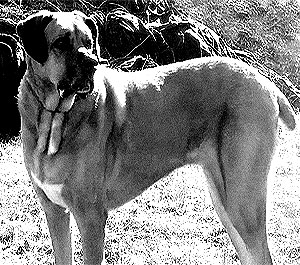Serbian Beardog
 There are a few theories concerning the origins of this breed, from those that are tracing its roots to the Assyrian Mastiff to the ones claiming that this is in fact the only direct and true descendant of the Alaunt. Most authorities believe that the old Serbian Beardog was developed from ancient Molossian hounds of Greece, mountain dogs of the Balkans and various war mastiffs brought by the Romans. By the Middle Ages it was established as a guardian of castles and military camps, but was also a popular hunter, fighter and bear-baiting dog. Said to had been colossal in stature and ferocious in personality, the Rashka Mastiff was a valued watchdog and large game hunting dog of the Serbian nobility.
There are a few theories concerning the origins of this breed, from those that are tracing its roots to the Assyrian Mastiff to the ones claiming that this is in fact the only direct and true descendant of the Alaunt. Most authorities believe that the old Serbian Beardog was developed from ancient Molossian hounds of Greece, mountain dogs of the Balkans and various war mastiffs brought by the Romans. By the Middle Ages it was established as a guardian of castles and military camps, but was also a popular hunter, fighter and bear-baiting dog. Said to had been colossal in stature and ferocious in personality, the Rashka Mastiff was a valued watchdog and large game hunting dog of the Serbian nobility.
While the largest dogs were the most appreciated ones, it is thought that there was a variety of types within the breed, the larger Rashka Mastiffs being primarily property guardians, while the smaller variants were used as hunters and fighters. It has even been suggested that it was the medium-sized dogs that were the true Metchkar breed, since their agility and tenacity made them ideal for the duties they were expected to perform. This is based on the assumption that the tallest and heaviest dogs were nowhere near as athletic and were therefore kept only as watchdogs and Royal companions. However, due to the lack of reliable information on either of these types, the Metchkar and the Rashka Mastiff are viewed as the representatives of a single breed, known as the Old Serbian Mastiff.

 These aggressive dogs weren't popular among the peasants who were partial to their old and reliable shepherd dogs, such as the Sylvan, Sarplaninac, Tornjak and others, but it is also believed that the common men weren't allowed to own and breed the Metchkar. Almost exclusively kept by the Rashka aristocracy, the Serbian Metchkar Mastiff was prized for its noble heritage and spirit. Some historians suppose that the Serbs might have used these dogs in their battles against the Turks, although there is no substantial proof of that. Some referrences in folk tales and war songs from the Middle Ages have been linked to the Serbian Mastiff, but this theory, even though quite sensible, still requires more research. Most authorities agree that the breed probably didn't survive the Ottoman occupation and by the end of the 19th century, there were very little pure specimens left.
These aggressive dogs weren't popular among the peasants who were partial to their old and reliable shepherd dogs, such as the Sylvan, Sarplaninac, Tornjak and others, but it is also believed that the common men weren't allowed to own and breed the Metchkar. Almost exclusively kept by the Rashka aristocracy, the Serbian Metchkar Mastiff was prized for its noble heritage and spirit. Some historians suppose that the Serbs might have used these dogs in their battles against the Turks, although there is no substantial proof of that. Some referrences in folk tales and war songs from the Middle Ages have been linked to the Serbian Mastiff, but this theory, even though quite sensible, still requires more research. Most authorities agree that the breed probably didn't survive the Ottoman occupation and by the end of the 19th century, there were very little pure specimens left.
The breed vanished in the early 1900's, although some fanciers believe that a number of unpure examples might have survived the First World War, with some representatives reportedly still being encountered during WW2 in some regions, before dying out altogether in the 1950's. However, stories about this majestic Moloss remained and in the 1980's the Serbian Mastiff breed has been re-created under the Serbian Defense Dog name. There are reportedly additional revival programmes underway as well, including some that are focused on re-constructing specific types of the breed, such as the Sandzak Mastiff experiment. As of yet, none of these other efforts have given satisfactory results, but it is only a matter of time before potential developers succeed in re-establishing this legendary Serbian Molosser.

 The head of the Metchkar is large and broad, with a defined stop and a long, powerful muzzle and well-developed jaws. The neck is fairly long and muscular, with moderate dewlaps. Straight-backed, wide-chested, long-legged and strongly boned, this mastiff resembles ancient Suliot Hounds and early Deutsche Dogges, as well as the Danish Broholmer and similar breeds. The tail is docked and the ears are left unaltered.
The head of the Metchkar is large and broad, with a defined stop and a long, powerful muzzle and well-developed jaws. The neck is fairly long and muscular, with moderate dewlaps. Straight-backed, wide-chested, long-legged and strongly boned, this mastiff resembles ancient Suliot Hounds and early Deutsche Dogges, as well as the Danish Broholmer and similar breeds. The tail is docked and the ears are left unaltered.
There were a few types of the Old Serbian Mastiff, mostly separated by size and their specific duties, coming in a few colourings, like the brindle Sharatz, fawn Zhuyan, black Gavran and the least common and fairly unpopular white Alban. The coat is short, hard and dense. Average height for the smaller variety is around 27 inches, while the larger type measures up to 35 inches at the shoulder.
